Chapter 1. Welcome to Windows Vista
In This Chapter:
- Preview Vista’s new features
- Understand the different Windows Vista versions
- See Vista’s amazing Aero Glass in action
- Gain an understanding of Microsoft’s goals for Windows Vista
Move over Windows XP, there’s a new kid in town!
Windows Vista dramatically changes the face of Windows, but the extent of those changes is hardly just skin deep. In addition to putting on that new face, Microsoft redesigned Windows Vista internally to provide you more power, more flexibility, and more ways to do the things you want to do while at the same time adding advanced security features that help keep you safe.
It’s best to experience Windows Vista from a high level when you first learn about it. There’s no need to get into the nitty-gritty details right now. By getting an overview of the operating system early, you’ll quickly get a better feel for what Vista can do for you right now.
A Complete Redesign of Windows Awaits You
More than five years passed after Microsoft released XP before Vista arrived on the scene. Microsoft hopes that the underlying code of Vista will be the basis of your operating system for the next decade, twice as long as the expected lifespan of XP. As with any other product, Microsoft will surely release updates throughout Vista’s life.
One reason Microsoft hopes that Vista lasts for a decade or longer is the extraordinary effort required to produce this new and improved operating system. As hardware gets more advanced, and the needs of end users matures, the operating system must keep up that pace and take advantage of features the hardware offers, while allowing users to accomplish more tasks in less time. It just takes longer to produce a fresh, rewritten, and revamped operating system today, so its shelf life needs to be longer to give Microsoft (and competing vendors) time to produce the next one.
When you first experience Vista, you’ll notice several things. As you look at Figure 1.1, notice the following:
- Vista initially sports a clean interface without a lot of icons (you can always add icons).
- The Welcome Center is a window set to load automatically when you first install or upgrade to Vista. The Welcome Center is a window that displays common tasks a typical new user to Vista might wish to do. You can turn off the Welcome Center’s display by clicking the Run At Startup option at the bottom of the window if you don’t wish to see it each time you start Windows Vista. Chapter 2, “Exploring the Welcome Center,” describes how to make the Welcome Center work best for you.
- Vista shows more detail in its icons.
- Although it’s clearly different, if you’ve used a previous version of Windows, Vista’s user interface (UI) will still be familiar to you.
Figure 1.1. When you first look at the Vista screen, you don’t see much there and you don’t see a lot of difference from Windows XP and other Windows versions.
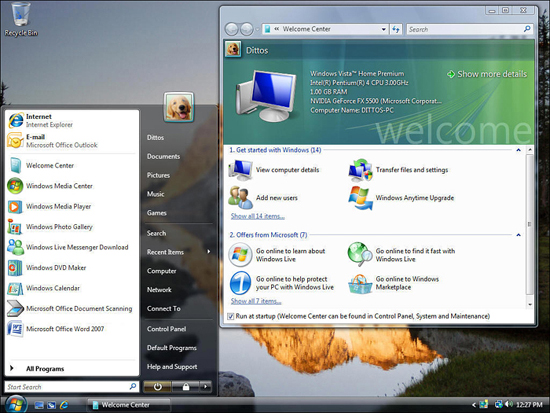
At first glance, therefore, Vista is not too impressive, right? Hang on! The nice thing about Windows Vista is that it is familiar to you. You wouldn’t want to adapt to a dramatic change when moving from one version of Windows to another. Having said that, from this point forward, you’ll start to notice how differently Windows Vista acts when you actually start to use it. Don’t worry about having to adapt, though. These differences really just represent evolutionary improvements that allow you to achieve your computing goals better.
By the Way
Your screen might look different from Figure 1.1’s because your desktop’s background (called wallpaper) might be set to a different picture. In addition, your computer might show far more icons than the figures in this book. It all depends on your PC’s vendor (if Vista was preinstalled), what was on your PC previously (if you just upgraded the operating system), and what you’ve added to Vista since it was installed. This book’s Vista computer was set up with nothing installed other than Vista, Microsoft Office, and a few utility programs. This keeps the screens more universal, but it also means you might see a few things on your screen that won’t always appear in this book’s figures.
Graphical Differences with Aero Glass
Just for grins, look at Figure 1.2. This shows how Windows remains the same but ups the ante by boosting what it does for you. The mouse cursor is pointing to one of the taskbar’s open program buttons. Instead of text telling you what the window is, you see a miniature image of the actual screen, called a thumbnail. At the same time, Figure 1.2’s user is pressing Alt+Tab to move between open programs. You’ve surely done that many times in Windows XP and earlier versions. This time, you don’t see icons representing those programs you’re tabbing through; instead, you see thumbnails there as well! No more guessing as to which open program you want to select.
Figure 1.2. Windows Vista is more graphical than previous Windows and provides thumbnail images of your open windows on the taskbar and task switcher.
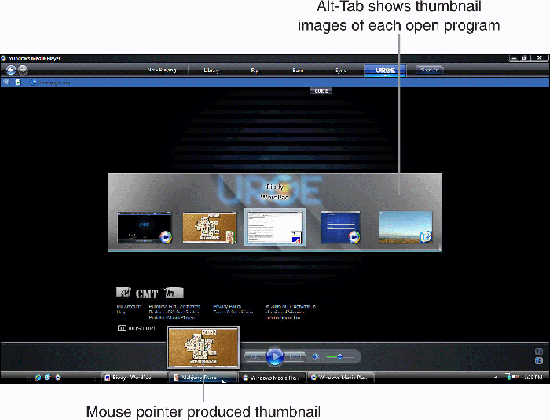
You’re seeing an example of Windows Vista’s Aero Glass mode. Aero Glass is the name Microsoft gave Vista’s advanced graphical features, such as the ability to see thumbnails in the taskbar and task switcher. In addition, Aero Glass gives the edges of your open windows a transparent effect so that you can see what one window is covering.
Aero Glass also features complete and true scalability of fonts and graphics. This means you can resize just about anything on your screen, from text to graphics to thumbnails without having an image become a pixilated mess. You can even rescale web pages that were not designed with text and graphics that normally could be zoomed in or out. If your monitor’s resolution makes text on a web page or a Word document difficult to read, you can increase the size of the font. Although you could sometimes increase the viewing font size of web pages and graphics before, Vista’s Aero Glass capabilities make this a more universal feature that just plain works better for almost anything and everything you do on your computer.
For another Aero Glass feature sporting a graphical wow factor, look at Figure 1.3. Here you can see several open windows in a 3D presentation called Flip 3D. With Flip 3D you can switch between all your running programs and open windows by pressing Windows+Tab to see this 3D representation of everything. From here, you can use your mouse’s wheel to scroll through a live view into each program. By looking down through these 3D windows you can more easily select the program to which you want to switch. (The Alt+Tab task-switching feature still works as shown in Figure 1.2, but doesn’t display your programs and windows in the 3D format.)
Figure 1.3. Press Windows+Tab instead of Alt+Tab when you want to see this Flip 3D representation of your running programs and open windows.

Watch Out!
Windows Vista requires a fairly powerful computer. Just about any medium- to high-end computer made from 2005 forward should handle most or all of Vista’s capabilities. Even if you have a machine powerful enough to run Vista, your graphics card might not be able to support the Aero Glass mode. If not, you will still enjoy most of Vista’s other features. Instead of seeing the Aero Glass interface, however, you’ll see a more traditional windowing effect, as Figure 1.4 shows.
Figure 1.4. Without a graphics card capable of handling DirectX 9 (or higher) and 3D graphics, your Windows Vista screen loses the capability to use transparent windows and displays icons in place of the thumbnails that would otherwise appear as you work.
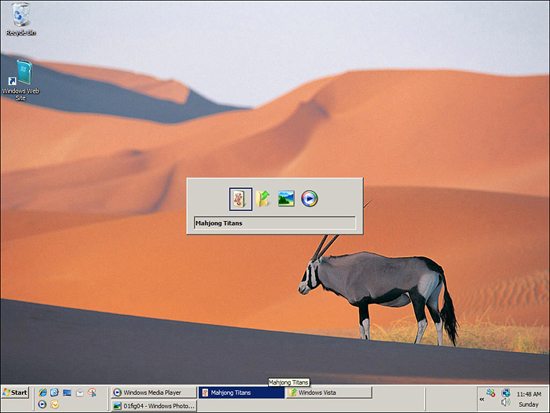
If you’ve been reading about Vista, you might have already seen some of these Aero Glass changes. Although the graphics are impressive, Vista is more than just a graphical remodeling of previous Windows versions. The next few sections touch on more highlights of Vista.
By the Way
Not all Vista installations support all features. Later in this chapter, in the section titled “The Vista Editions,” you’ll learn what Vista flavors are available and how they differ.
A Leaner and Cleaner Start Menu
The first thing you click in Vista will probably be the Start button (which is no longer labeled Start, and instead is the Windows logo). The Windows Vista menu pops up as expected but, unexpectedly, as you select options from inside the menu, you’ll immediately notice that the menu stays in one column instead of spreading all over your Windows desktop like the plague.
Instead of cascading through layers of menus, Vista’s menu lets you drill down into menus and submenus by changing the Start menu to reflect what you’ve selected. For example, if you select Start, All Programs, Accessories, your Vista menu will look something like the one in Figure 1.5: a single-columned list of all the options in the Accessories menu. Keeping the clutter away from Vista’s menus means that you can see more of your screen, which is often useful when you’re using the Start menu to look for data or programs related to something you’re doing.
Figure 1.5. The Start menu stays in one column, letting you see more of your screen and keeping the menu options more concise.
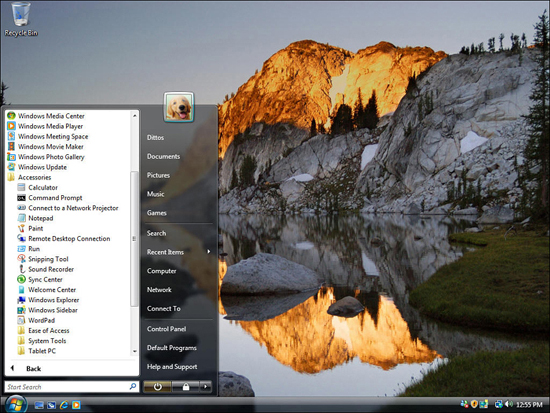
Vista Has Vastly Improved Security
Windows XP was been a major upgrade over Windows 9x or Me, but there’s no question it was still a security nightmare. Microsoft worked diligently to make Vista far more bulletproof than XP. In defense of Microsoft’s job on XP, many of the security risks that affected users over the past few years were certainly unexpected. They were often the result of new hardware or software technology that wasn’t foreseen at the turn of the millennium when Microsoft released XP. Many security pitfalls were often the unexpected outcome of innocent and unsuspecting users clicking the wrong thing, such as an unexpected attachment from an email sent by a suspicious source or masked as being from someone they know.
No matter how much more secure you might have wanted XP to be, when you first begin using Vista, you might think that Microsoft worked too diligently on security due to how much you’ll have to interact with Vista’s warning and permission security messages.
Windows Vista introduces User Account Control, or UAC, which verifies that system changes and some system-related programs should run before actually running those programs and causing potential problems. The UAC permeates much of Vista and even if you are logged in as an Administrator you’ll be prompted to verify certain tasks as you use Vista. When you attempt to run a program such as the Disk Defragmenter, Vista opens a dialog box entitled User Account Control and requests that you confirm you want to run the program. If you’re not logged in as an Administrator user then you must enter an Administrator user account’s password to run the program.
Vista must adapt to the way you want to work. Because Vista errs on the side of caution, it’s extra secure and blocks some things you won’t want blocked. Fortunately, Vista usually asks permission to block things at first and you can train Vista, over time, to know what to allow and what to block. (Although there will always be actions that require your confirmation to execute.)
Many home users and users of standalone computers that might or might not be connected to the Internet are considered Administrators, or the masters of their computers. By being an Administrator, you in effect have full control over the computer as opposed to some user accounts that you might set up that are more limited. Non-Administrator accounts are called standard accounts. Some standard accounts on your computer, for example, might not be allowed to install new programs (very wise if you share your computer with other members of the family, especially those who love to download and install lots of games).
By setting up the Administrator account for yourself (the first account set up after you install or begin using Vista on a new computer), and the more-limited standard accounts for others in your family or those who work with you on your computer, you help protect your system from programs and downloaded problems later. The standard accounts can allow others to use the computer and run programs but not change any significant system properties or install possibly malicious programs.
By the Way
Vista provides several layers of parental controls so that you can determine exactly what members of your family can and cannot do. You can even go so far as to control what days of the week and times of day they can log in to and use the system. You, as Administrator, can adjust those parental control settings. Users without your Administrator use privileges cannot adjust the settings.
Both Vista and XP offer you the ability to create accounts with various capabilities as just described. In many instances, Vista asks the Administrator whether to allow something before doing it. For example, if you connect a new device to your computer and Vista needs to install a software driver for that device, Vista asks your permission, even if you are using the primary Administrator account (which most of you will probably be using if you’re the primary user of your computer or the one who set up the computer).
By the Way
A driver is a small program that tells the operating system how to interact with a hardware device. Every piece of hardware on your computer, from your mouse and keyboard, to your printer to your graphics card has drivers that tell Vista how to make use of them.
You’ll see many more requests like the driver installation request as you use Vista. If you have permission to grant or deny the request, Vista follows the marching orders you give it. If others who use your computer on a more limited basis try to grant or deny such a request, Vista ignores their response and waits for you to decide when you get back to your Administrator account.
Did you Know?
Even if you are your computer’s Administrator, you might want to add a second user account for yourself that is a Standard user giving you more limited access than the Administrator account. Using the more limited account until you gain more familiarity with your computer might be wise so that you don’t inadvertently allow or deny something incorrectly that pops up and needs your attention. Besides, Vista allows you to run any program as an administrator by supplying an administrative password.
Of course, Vista’s security also extends to online activities. Vista offers a stronger firewall, a program that monitors online and network activity and tries to keep other users’ computers from snooping through your files and possibly wreaking havoc with your programs and data. Unlike the Windows XP firewall, Vista’s firewall can be setup as a two-way firewall, meaning that Vista monitors all outgoing online and network activities as well as incoming. (XP only monitored incoming traffic.) Monitoring outgoing traffic is important because some Trojan horse programs can infect your computer and begin using your Internet and network connection for activities you didn’t authorize. The 2-way firewall goes a long way toward intercepting and preventing such unauthorized attempts.
By the Way
Chapter 27, “Managing Your Windows Security,” explores the many ways that Vista protects you and explains how you can set up and control Vista’s security to work in your computing environment.
Find So Much More So Much More Quickly
Vista offers an integrated search feature that runs circles around XP’s cranky, bulky search operations. Perhaps you’ve used a desktop search system in the past such as Google’s or MSN’s desktop search engine. Such desktop search engines index files and data all over your computer and quickly locates them when you search for them.
Vista includes such a search window, accessible by clicking Search from the Start menu. You can hunt for specific files or hunt for text inside files. The text for which you’re searching can reside in any number of file types, ranging from text documents, to spreadsheets to email (and more), making both much faster and more dynamic than the old Windows XP Search program.
Vista helps you craft your search in many ways. In Figure 1.6, the user is searching for the word stocks. But as the user types stoc, a list of files appear that either include the letters stoc in their filename or include the letters stoc inside the files somewhere. (Even if the files are MP3 digital music files, all the MP3 tag information is searched.) That’s why you see so many files in the list until you finish typing your search term in the Search box. The Vista Search box looks through websites you’ve stored in your Favorites folder, as well as other files, news, and even email you’ve collected onto your computer.
Figure 1.6. Vista provides high-speed searching and begins to return matches even before you finish typing what you’re looking for.
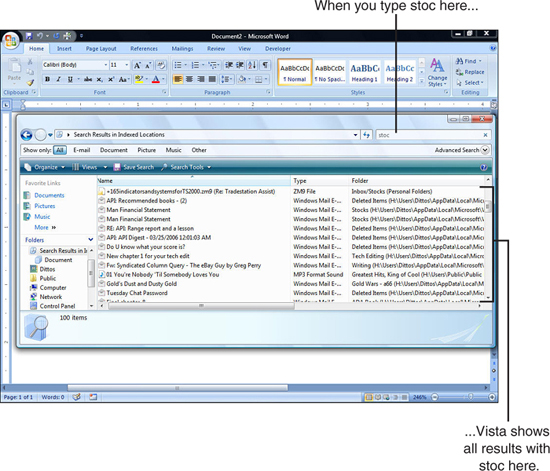
By matching your search text as you type it, you don’t always have to finish entering the complete search word or phrase before locating what you want to find. If the file or text you’re looking for appears in the search results before you finish typing the search phrase, just double-click that item to open it without finishing your search phrase.
By the Way
Windows Vista’s search results window is really just a specialized Explorer window. That’s why the window is referred to as a Search Explorer window.
You can search for programs and data from many places inside Vista. It’s almost as though Microsoft reads your mind because when you need a search box, it’s there. You’ll even find a search box at the bottom of the Start menu! Just begin typing letters for something you want to find in the Start menu’s search box and the results appear right there on the Start menu (see Figure 1.7). One reason Vista is so quick to locate results is because Vista constantly indexes files, emails, MP3s, pictures, visited websites, and everything else you store on your computer in an effort to locate any of these items quickly if you search for text that matches any of the indexed terms found in those files.
Figure 1.7. You can type your search word or phrase at the bottom of your Start menu and Vista searches programs, stored web pages, news, and emails that match your results.
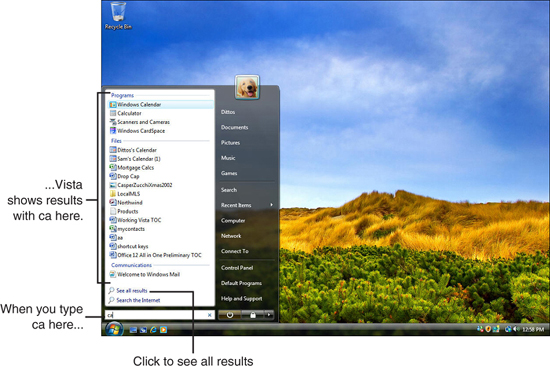
Did you Know?
You’re never limited to searching your own computer. When you search for anything, click the Search the Internet option in the search panel and Vista hands off your search to an online search engine (that you can specify) and displays the online results.
Vista Introduces a Better Internet Explorer
Although Internet Explorer isn’t technically an operating system feature, Internet Explorer got its first major upgrade in almost a decade when Vista brought us Internet Explorer 7.
As you might expect already, Internet Explorer (IE) takes advantage of graphics in ways that previous versions didn’t. Vista’s Aero Glass feature means that you can scale website text larger or smaller even if the site isn’t designed to offer scalable text (and many sites are not). In previous versions of IE, you simply could not change the text size of some sites to make them more readable or to show more text on the screen, but Vista makes it possible now to do just that.
In addition, IE finally offers tabbed browsing. As Figure 1.8 shows, you can open multiple websites inside a single IE window. A tab marks the name and location of each open website. Click a tab to make its website appear on top in the window.
Figure 1.8. Click a tab to see that page inside a single IE window.
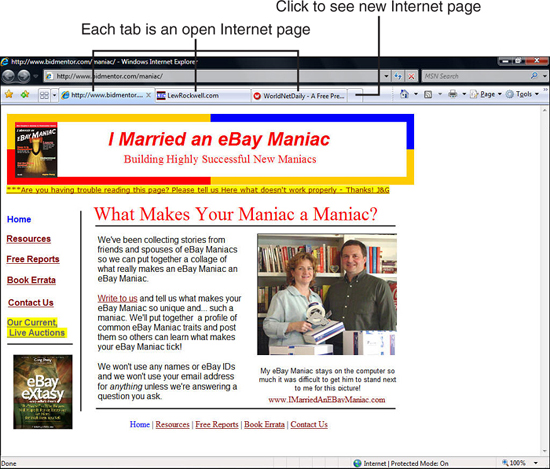
With older versions of Internet Explorer, you’d have to open a new IE window to see a different website if you wanted to keep several sites open at once. You can still do that, but after you begin using the tabbed browsing feature, you’ll find that your Windows taskbar is far less cluttered with multiple open IE windows.
Although the tabs toward the top of the IE window tell you what each website contains, you can click the Quick Tabs button (or press Ctrl+Q) to see a full-screen preview of all the tabbed windows, as Figure 1.9 demonstrates. These thumbnail views show the page that each IE tab represents. Click any thumbnail image to display that web page (in effect, moving that page’s tabbed page to the top of the IE stack of tabbed websites).
Figure 1.9. A preview of your open web pages makes locating the page you want to browse next simple and accurate.
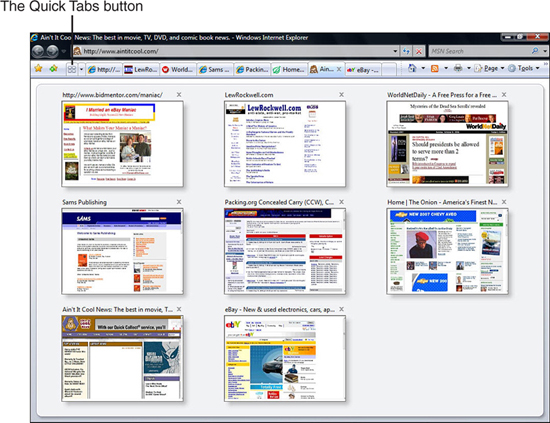
Before, you might have had to click through several open IE windows to get to the open Web page you wanted to work on next. The tabbed browsing and thumbnail previews make browsing the Internet more intuitive and quicker to manage.
IE adds other new features such as RSS feeds (Really Simple Syndication; feeds that alert you to new web content instead of you having to browse to it) and security enhancements such as a phishing detector that lets you know when you’re browsing a site that isn’t what it appears to be. Phishing is a deceptive tactic spammers and other nefarious Internet types often use to make their emails look like another company’s and provide links to a website that looks like an official site, but is a mocked-up version that is trying to trick you into entering your password or other personal information (like bank account numbers). For example, an email might direct you to a phony-but-real-looking eBay site. These phishing sites are far less dangerous with Vista than with earlier operating systems in part because the new IE maintains a reference database of known phishing sites and it can warn you if the site you’re browsing is one of them.
By the Way
If tabbed Internet browsing, thumbnail previews, and RSS feeds seem familiar to you, it’s because other browsers such as Firefox have offered similar features for years. True, IE is behind the times, but Vista’s Internet Explorer works great and is a welcome improvement in spite of its tardy feature set.
Pictures and Multimedia Improve in Vista
Microsoft revamped XP’s anemic My Pictures window to provide organizing tools that makes the Windows Photo Gallery vastly more usable and helpful. In addition to new tagging and organization features, you can perform routine photo editing, too.
With the Photo Gallery, you can organize and track both pictures and videos. When you search for pictures and videos, Vista limits the search to the items in your Photo Gallery. You can select which items the Photo Gallery includes because Vista doesn’t force you to use one folder, such as My Pictures, to hold the pictures (and videos) it tracks.
Figure 1.10 shows the Windows Photo Gallery with some of the options available. A thumbnail image appears for each picture and each video you include in the Photo Gallery. The thumbnails used for each video represent the first video frame of each video.
Figure 1.10. The Windows Photo Gallery not only organizes your photos and videos, but also enables you to make routine edits to your pictures.
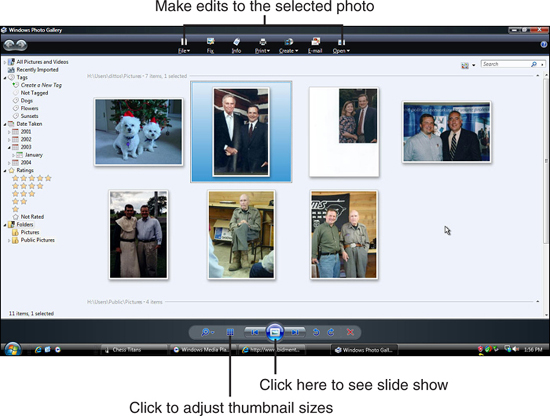
From the Photo Gallery, you can
- Adjust picture colors
- Change the photo brightness and contrast
- Crop pictures
- Remove red eye
- Add ratings to your photos so that later you can more easily locate the best of the bunch
- Assign tags to pictures to add comments and search terms to your photos and videos so you can locate them later
In other words, Vista’s Windows Photo Gallery performs many tasks that you had to purchase photo-editing software to do before. Although photo-editing software such as Photoshop Elements has far more features than Windows Photo Gallery, you’ll find yourself using Photo Gallery for many routine editing tasks without having to start another program to make simple adjustments, and for adding tags and ratings to your pictures.
Watch Out!
If you’ve been using a different photo album utility, such a the album feature in Adobe Photoshop elements, note that any tags you’ve applied to those photos do not carry over when viewing them through Photo Gallery.
Did you Know?
Given Vista’s superior capability to resize text and graphics on the fly (if your graphics hardware and Vista version support the Aero Glass feature), it’s also worth noting that you can also easily resize your Photo Gallery images. Hold the Ctrl key and move your mouse scroll wheel (or your trackball’s wheel) to resize the thumbnail images on the fly.
Although the Windows Photo Gallery organizes and keeps track of both pictures and videos, you’ll still use the Windows Media Player to play videos and music. The Media Player has gotten so powerful over the past few years that many users use it exclusively and no longer rely on outside (and costly) programs to play music and video, transfer music to a disk (called ripping), and burn music CDs.
Vista’s Media Player is more graphical, representing more content with graphics from the original CD cases and album covers. You’ll locate music and videos faster using Vista’s integrated search tool that you’ve already read about in the earlier pages of this chapter. Start typing a song you want to listen to and as you type the characters, Media Player displays matching results right away.
The Cool Windows Gadgets
Vista introduces Windows Sidebar gadgets, which displays several Gadgets small programs (sometimes known as applets, making one think of tiny applications). Vista includes a handful of gadgets but you’ll be able to download more, often without any charge, from Microsoft and other sites.
These gadgets, which are similar in nature to the widgets available for the Mac OS, are little programs that do something simple you need. Perhaps it’s just a clock showing you the time. Perhaps it’s a stock ticker symbol scrolling by. Perhaps you want a calculator always handy. The possibilities are really quite limitless.
The nice thing about Windows gadgets is that you dock them to the side of your screen in the Windows Sidebar, as shown in Figure 1.11. The gadgets remain there for you to use when you need them. You can easily hide the Sidebar and bring it back by right-clicking the gadget icon in the notification area (the lower-right part of your screen to the right of your Windows taskbar).
Figure 1.11. Put gadgets—small applications that help you accomplish tasks you need done routinely—on your Windows desktop’s Sidebar for one-click access to them.
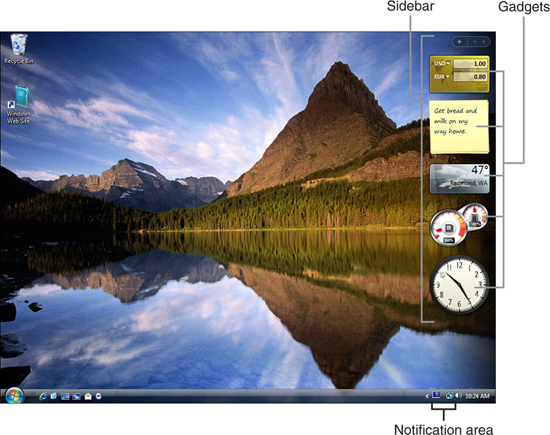
Did you Know?
If you use multiple monitors, you can place the Sidebar on either monitor to keep it out of your way but still make it available for quick access.
Chapter 9, “Working with the Sidebar and Gadgets,” explores the many ways you will be able to use gadgets with and without the Sidebar.
By the Way
At first, some users cannot see a gadget’s advantage. For example, you can quickly start the Windows Calculator program from the Start menu or simply add an icon for the Calculator to your Taskbar’s Quick Launch toolbar (as Chapter 6, “Taking the Taskbar to Task,” explains). By being on your desktop and open, the Sidebar’s programs make them always visible. A single glance tells you a latest stock price, for example, without you having to click an icon to start a program.
Vista’s New Features Keep on Coming
Vista offers so much. You’re surely anxious to get started trying many of them out, now that you’ve read about them in this chapter.
Your Vista new feature preview won’t end here, though. Vista offers so many new features that you’ll be running across new features and easier ways to do your work all throughout this text and beyond. Not only that, of the new features I’ve discussed here, I’ve hardly scraped the surface of what many of them can do. As this book leads you through the use of Windows Vista and shows you how to make Vista do the work you want it to do, you’ll see many new bells and whistles as well as improved functionality of old favorites.
The Vista Editions
For years, Microsoft has offered various editions of each Windows release. Windows Vista is no exception. These editions are similar because each is a subset of Vista, but the features differ among them.
It’s true that the various Vista editions, especially when you first hear about them, seem a little confusing. Microsoft certainly doesn’t offer the various editions to confuse anyone. Instead, it’s Microsoft’s goal to provide an operating system that best serves your needs no matter what computing environment you work in and no matter what hardware you use (as long as your equipment isn’t too outdated). Not only that, but if you don’t have a need for some of Vista’s more advanced or niche features, getting a “lighter” version of Vista can save you some money, too.
By the Way
Any medium- or high-end computer manufactured after 2005, and most higher-end computers made after 2003, should run some Vista edition with little or no problem. To see if your hardware is Vista-capable, the following link takes you to a Microsoft Web page that installs the Windows Vista Upgrade Advisor tool. With that you can learn how well your machine will run with Vista and you’ll learn ways you can make your computer more Vista-ready if it’s not currently: http://www.microsoft.com/windowsvista/getready/upgradeadvisor/default.mspx.
As time goes by, the release versions of Vista might change, so this information is as current as it can be at the time of this writing. In the past, Microsoft has released additional flavors of Windows long after the initial products debuted; Microsoft has also removed some flavors in the past.
In general, there are three home versions of Vista. Even though these are considered “home” versions, many small businesses will probably adopt and use one or more of these as well. Here is a rundown of the home Vista versions:
- Windows Vista Home Basic—A features-"lite” version, similar to Windows XP, that easily runs on lower-level computers. Even if you happen to have an adequate graphics card, note that no Aero Glass features are present in this version.
- Windows Vista Home Premium—This middle-of-the-road Vista flavor is probably what most home and very small business or home office users will use. Aero Glass, Media Center multimedia functionality, networking, Tablet PC support, and most of the operating system’s feature set are included.
- Windows Vista Ultimate—Everything possible in Vista (including the Business and Enterprise versions) is available in this ultimate version, including advanced networking support, extra efficiency routines that make high-powered games run smoothly, and an upgraded support service agreement to get quicker response to your questions and concerns.
In addition to the home versions, Microsoft is offering Windows Vista Business, a version similar to the Vista Home Premium but includes extra utilities and better networking tools that corporate users might find useful.
Microsoft also is offering a deeply trimmed-down version called Windows Vista Starter. Developing nations with generally limited hardware can use many of Vista’s simpler features without slowing their older computers to a crawl. As such users upgrade to more modern hardware, they will be able to take advantage of the higher-end Vista flavors.
Business users who need more power than Vista Ultimate or Vista Business will require Windows Vista Enterprise. This operating system is tweaked to work well in enterprise environments, which maintain large networks in multiple locations and require advanced security, more control, and wholly integrated file sharing. A slightly narrower Vista without the vast networking (enterprise) features is called Vista Business.
By the Way
Microsoft is releasing some Vista flavors without Media Player in an attempt to appease some competing media player firms that offer similar media products. The N releases are primarily sold for European users to help alleviate some anti-trust cases related to Windows. If the name of your Windows Vista has an N in it (such as Windows Vista Home N), you won’t have the Media Player and you won’t be able to save files in the Windows Media Audio format with the .wma filename extension unless you have third-party software that will do so. You can download Media Player from Microsoft’s Web site at www.Microsoft.com if you want to use Media Player.
By the Way
Windows Vista comes on a DVD and a DVD can hold a lot of information. When you install Vista, you install the edition you purchased a license for (such as Vista Business, Vista Home Premium, or whatever). At any time, you can upgrade to a higher edition such as moving from Vista Home Basic to Vista Home Premium using the Windows Anytime Upgrade option on your Windows Start menu’s Extras and Upgrade folder. At the time of this writing, you pay only the difference in price between that which you originally purchased and the Vista version to which you want to upgrade.
Chapter Wrap-Up
Vista’s Aero Glass graphical interface is only the beginning of the changes Vista offers over XP. If you used XP in the past, it might seem odd that XP’s now considered archaic, but it truly is. Microsoft developed XP when hardware was simpler, security wasn’t as big an issue, and although the world was getting more wired, only a small percentage of users had always-on, high-speed broadband Internet service.
Now you need to understand more of what Vista represents from a 10,000-foot view; it’s time to look a little closer. Chapter 2 discusses the Welcome Center window, a window that provides new Vista users with tools they frequently need to begin using Windows Vista. After you get that background, you’ll dive right into using Windows Vista’s more routine features starting in Chapter 3, “Clicking Your Start Button."
